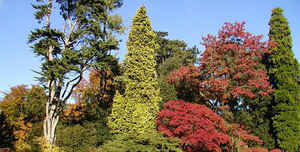
Utah Symbols
Utah State Tree
Quaking Aspen (New)
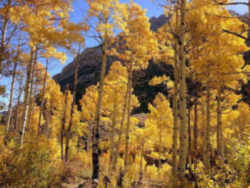
(Populus tremuloides)
Adopted on May 13, 2014.
The quaking aspen (Populus tremuloides) was chosen by the Utah State Legislature in 2014 to be the state tree. The quaking aspen replaced the Colorado blue spruce, which had held the honor of state tree since 1933. Aspen's main uses in Utah have been for fence poles and buildings, and as firewood. Some trees have been sawed into lumber or pulp. Recently, it has been used for paneling.
Utah State Tree: Quaking Aspen (New)
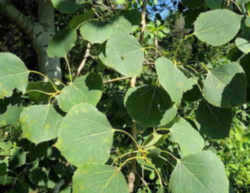
The quaking aspen, which is also known as trembling aspen, makes up about 10% of the forest cover in the State of Utah and can be found in all of Utah's 29 counties. In comparison, the Colorado blue spruce makes up about 1% of the forest cover and is primarily found in the the Wasatch and Uinta mountains.
The change was initiated by fourth-grade students at Monroe Elementary in Sevier County who didn't think that the Quaking Aspen represented the State of Utah as a whole. The students chose the aspen because a colony of trees develop a singular root system. They say that reminds them of Utah where we all work together to reach new heights. Senator Ralph Okerlund sponsored S.B. 41 because "the quaking aspen provides Utah an economical, agricultural and recreational benefit." The strong root system of the quaking aspen also appealed to Senator Okerlund because of the state's emphasis on family history and genealogy. S.B. 41 passed 26 to 0 in the Utah Senate on February 10, 2014 and was sent to the Utah House of Representatives for their consideration.
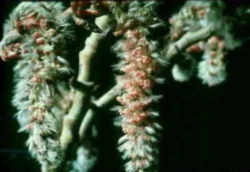
Representative Brad R. Wilson, floor sponsor of S.B. 41, believes the quaking aspen is an appropriate symbol for Utah. "The aspen stems grow from roots of older trees," Wilson said. "This creates a very important metaphor that we could connect to Utah as these children of the parents grow and are very prolific." It passed 54 to 19 in the House of Representatives on February 19, 2014.
Governor Gary R. Herbert signed the bill on March 26, 2014 at Monroe Elementary in front of the students who inspired the change. The governor signed the bill with 13 pens made from quaking aspen while sitting on a chair and at a desk made from the tree, as well. On May 13, 2014 the quaking aspen officially became the Utah state tree.
Utah gets a new state tree: Quaking aspen
February 12, 2014 12:35 am • Billy Hesterman - Daily Herald
SALT LAKE CITY - Legislation is making its way through Utah's Capitol that would fell the status of the Colorado blue spruce as Utah's state tree and
replace it with the quaking aspen.
The Senate gave final approval to the legislation on Monday as Senate Majority Leader Ralph Okerlund, R-Monroe, explained the many reasons the aspen
was more representative of Utah than the spruce.
"The blue spruce makes up less than one percent of Utah's forest cover and is found mostly in northern Utah," said Okerlund, the chief sponsor
of the legislation. "Whereas the quaking aspen makes up about 10 percent of the forest cover in the state of Utah."
Okerlund also explained that the aspen has created the largest living organism in the world in a cluster of trees located near Fish Lake known as the
Pando Clone. The clone covers 106 acres of land and has more than 147 stems included in it.
He stated that the aspen has proven to be economically beneficial to the state. According to Okerlund, many of the prized game animals that live inside
the state thrive in aspen areas. He also explained that the aspen tree is one of the main trees leaf peepers seek out when they go to view the foliage
in the fall.
"There is nothing like an aspen grove in the fall of the year," he said.
Okerlund's proposal comes from a fourth-grade class located within his senate district. Gov. Gary Herbert visited the district in 2013 and the students
petitioned him for the tree change as they wondered why the Colorado blue spruce was Utah's state tree. Herbert said he agreed and Okerlund found himself
running the legislation.
Sen. Pat Jones, D-Holladay, said she liked the change because aspens have many characteristics that represent Utahns. She said the connectivity of
the roots system was similar to the connectivity that the state has. She also said that aspens were survivors - another characteristic she said she
finds in a lot of Utahns.
The senate approved of the legislation unanimously. The students from the fourth-grade class that lobbied the governor were on hand for the passage
of the bill. Applause broke out in the senate chambers when it was approved. It now moves on to be considered by Utah's House of Representatives.
If the House approves of the tree change, the aspen will join a host of other items that have been declared official symbols of the state. Items such
as the cherry, the dutch oven, the Bonneville cutthroat trout, the sego lily and the John M. Browning-designed M1911 pistol are all official symbols
of the state of Utah.
Identification of the Quaking Aspen
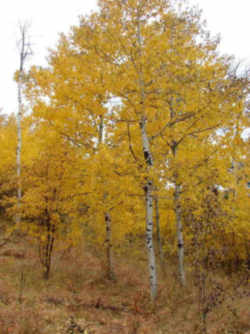 Populus tremuloides is
a deciduous tree native to cooler areas of North America, one of several species referred to by the common name Aspen. It is commonly called quaking
aspen, trembling aspen, American aspen, Quakies, mountain or golden aspen, trembling poplar, white
poplar, popple, and even more names. The trees have tall trunks, up to 25 m (82 ft) tall, with smooth pale bark, scarred with
black. The glossy green leaves, dull beneath, become golden to yellow, rarely red, in autumn. The species often propagates through its roots to form
large groves.
Populus tremuloides is
a deciduous tree native to cooler areas of North America, one of several species referred to by the common name Aspen. It is commonly called quaking
aspen, trembling aspen, American aspen, Quakies, mountain or golden aspen, trembling poplar, white
poplar, popple, and even more names. The trees have tall trunks, up to 25 m (82 ft) tall, with smooth pale bark, scarred with
black. The glossy green leaves, dull beneath, become golden to yellow, rarely red, in autumn. The species often propagates through its roots to form
large groves.
- Leaf: Alternate, simple, 1 to 3 inches long, green above and paler below, heart-shaped to nearly round with a fine toothed margin, petiole is flattened.
- Flower: Species is dioecious; male and female hanging catkins 1 to 3 inches long.
- Fruit: Catkin (2 to 4 inches long), with attached light green capsules which contain many small hairy seeds.
- Twig: Slender, glabrous, reddish brown often with a gray, waxy film; buds conical, reddish brown, terminal bud 1/4 inch long, may be slightly resinous.
- Bark: At first smooth, creamy yellowish-white to very light green; later developing thick furrows and becoming dark, especially near the base.
- Form: Small (30 to 40 feet tall) upright tree, which often occurs in thickets.
Adoption
Representative Brad R. Wilson, floor sponsor of S.B. 41, believes the quaking aspen is an appropriate symbol for Utah. "The aspen stems grow from roots of older trees," Wilson said. "This creates a very important metaphor that we could connect to Utah as these children of the parents grow and are very prolific." It passed 54 to 19 in the House of Representatives on February 19, 2014.
Governor Gary R. Herbert signed the bill on March 26, 2014 at Monroe Elementary in front of the students who inspired the change. The governor signed the bill with 13 pens made from quaking aspen while sitting on a chair and at a desk made from the tree, as well. On May 13, 2014 the quaking aspen officially became the Utah state tree.
Taxonomic Hierarchy: Quaking Aspen
Kingdom: Plantae - Plants
Subkingdom: Tracheobionta - Vascular plants
Superdivision: Spermatophyta - Seed plants
Division: Magnoliophyta - Flowering plants
Class: Magnoliopsida - Dicotyledons
Subclass: Dilleniidae
Order: Salicales
Family: Salicaceae - Willow family
Genus: Populus L. - cottonwood
Species: Populus tremuloides Michx. - quaking aspen






